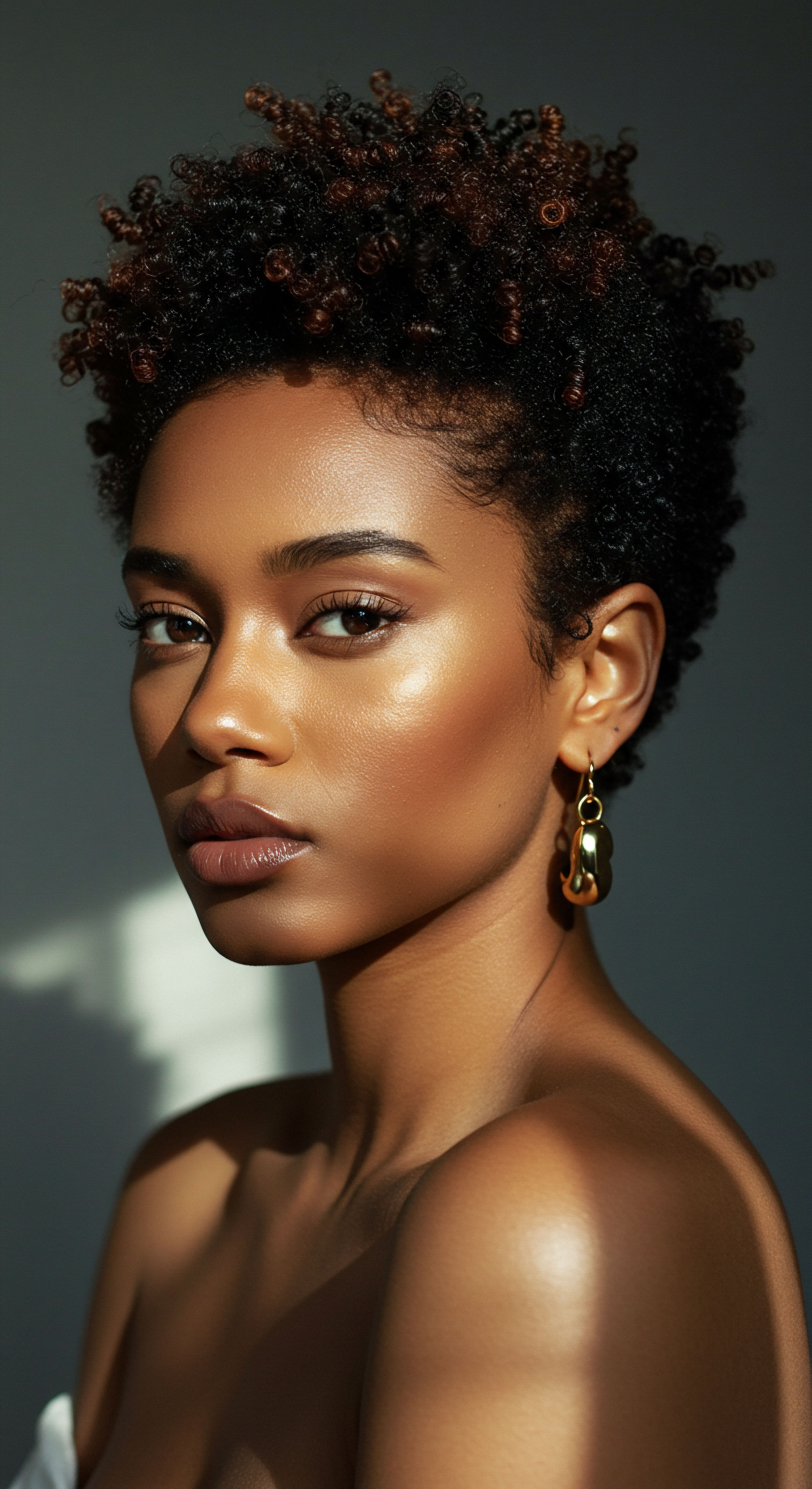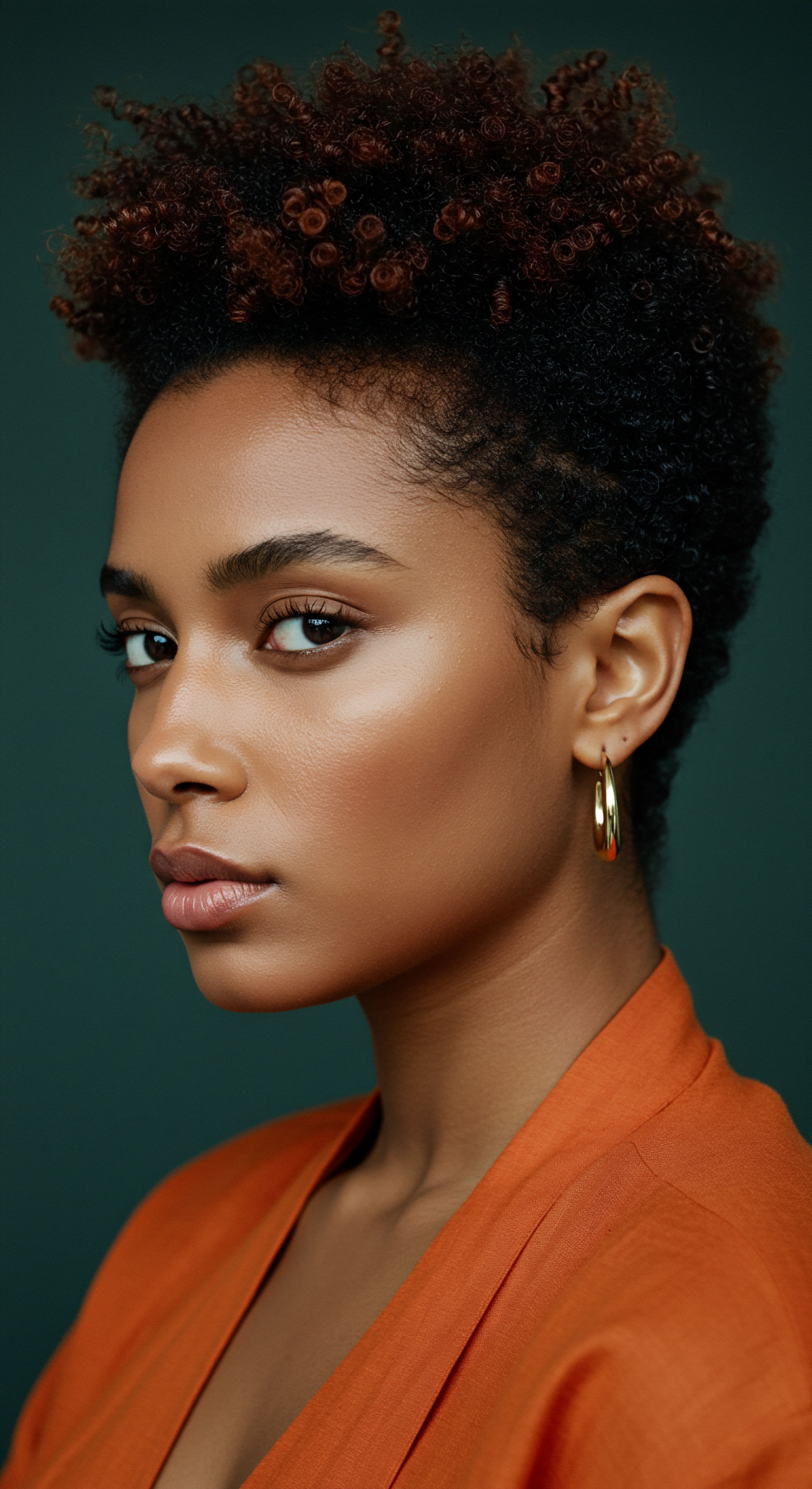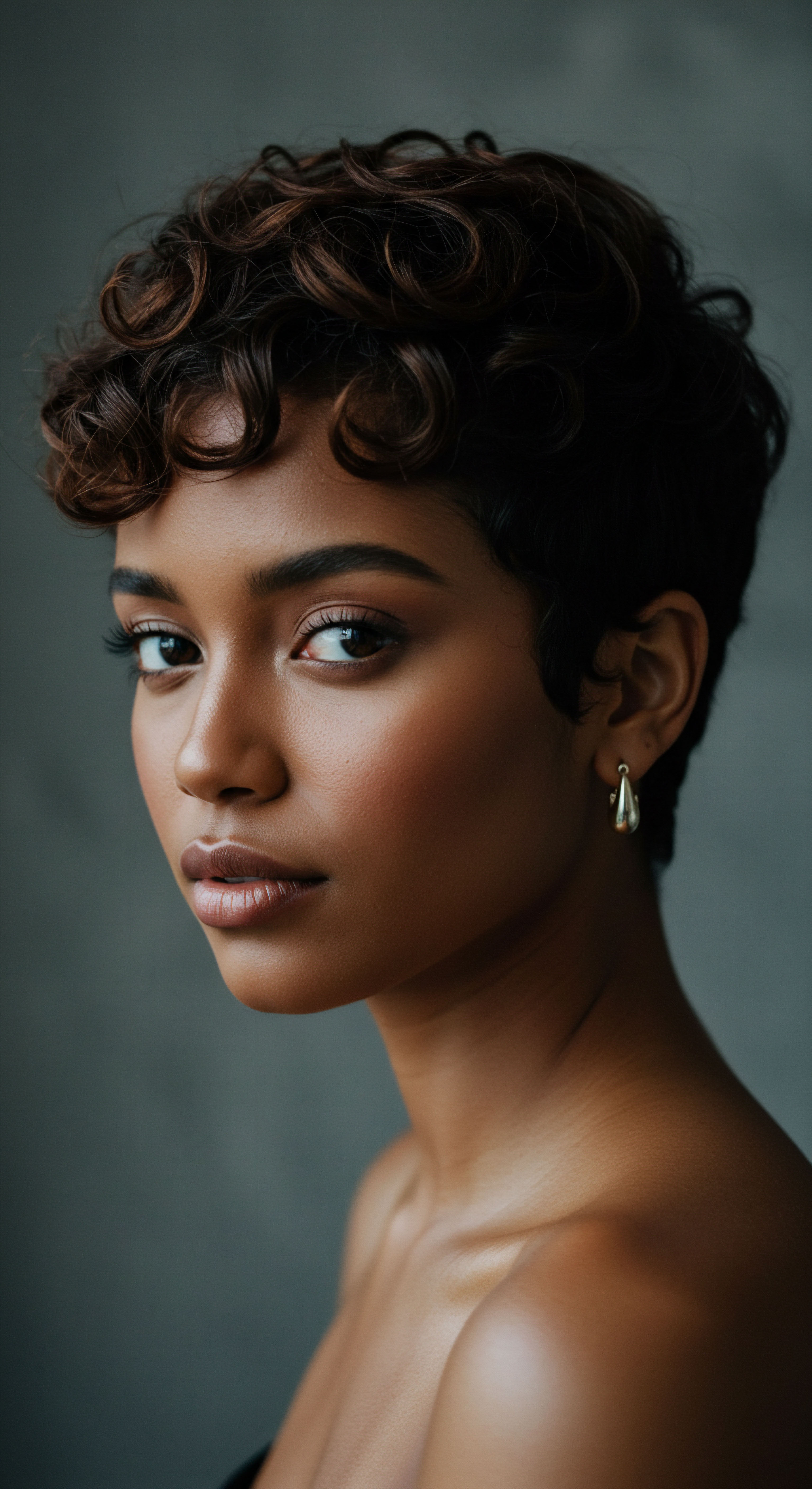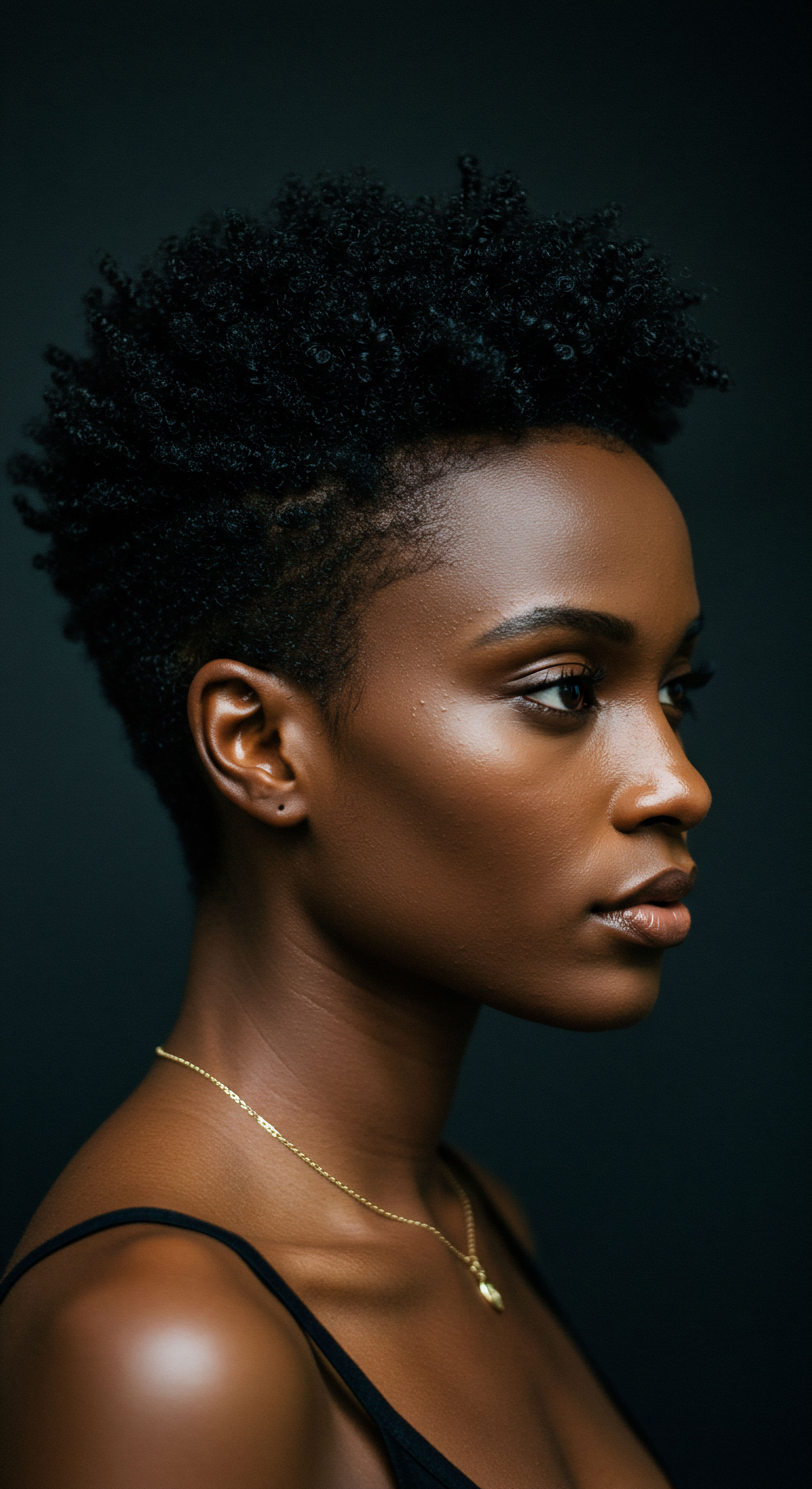
Roots
Have you ever woken from a night’s rest, perhaps feeling a little more rested than usual, and noticed a subtle shift in the very feel of your hair? A little more softness, a touch less resistance, or perhaps a slight recalibration of your natural curl? It’s a quiet observation, often dismissed as mere happenstance, yet it whispers of a deeper truth. Our bodies, in their magnificent complexity, operate on rhythms that govern far more than our conscious awareness.
Just as the earth turns, inviting the sun and then the moon, our internal world follows a profound cycle, influencing everything from our deepest cellular functions to the outward expression of our physical form, including the tactile quality of our hair. This understanding begins at the very root, where the life of each strand takes hold, guided by unseen biological currents that find their tempo in the patterns of our sleep.
The vitality of textured hair, with its unique structural needs and inherent tendencies, is intimately linked to the intricate dance of cellular repair and regeneration that occurs during periods of rest. Hair, a fascinating biological extension of our skin, is not a static entity; it is a dynamic tissue, constantly undergoing phases of growth, transition, and renewal. Each hair follicle, a tiny organ nestled within the scalp, possesses its own internal clock, a delicate mechanism responsive to the overarching rhythms of our being. When these rhythms fall into disarray, the very foundation of hair health can waver, potentially altering its appearance and feel.

The Hair Follicle’s Inner Clockwork
Each hair follicle is a hub of activity, cycling through distinct phases ❉ anagen, the active growth stage; catagen, a brief transitional period; and telogen, the resting phase before a new cycle begins. This cycle is not merely a linear progression; it is a finely tuned orchestration, heavily influenced by systemic signals. Among these signals, the body’s circadian rhythm plays a significant, though often underestimated, role.
The circadian clock, a roughly 24-hour cycle, governs a multitude of physiological processes, from hormone secretion to cellular metabolism. Within the hair follicle itself, clock genes are expressed, demonstrating an intrinsic rhythmicity that influences hair growth and even pigmentation.
The subtle changes in hair texture observed upon waking hint at a profound connection between our sleep patterns and the biological rhythms governing each hair strand.
Disruptions to this internal clock, whether from inconsistent sleep schedules or chronic sleep scarcity, can send ripples through the hair growth cycle. When the body misses its cues for deep, restorative slumber, the carefully timed cellular processes within the follicles can become asynchronous. This might mean a premature shift from the active growth phase into the resting phase, or a slowing of the cellular division necessary for robust hair production. The impact on hair texture might manifest as a diminished vibrancy, a feeling of increased brittleness, or a loss of that characteristic spring and resilience that defines healthy textured strands.
Consider the production of Keratin, the primary protein component of hair. Its synthesis is a complex process requiring specific conditions and a steady supply of building blocks. During deep sleep, the body prioritizes cellular repair and protein synthesis, creating an optimal environment for keratin formation. When sleep is compromised, this crucial nightly workshop operates at a reduced capacity, potentially leading to strands that are less fortified, more susceptible to damage, and thus, altered in their tactile quality.

How does the Body’s Internal Clock Influence Hair Growth?
The body’s internal clock, the circadian rhythm, acts as a master conductor for numerous physiological processes, including those that govern hair growth. This rhythmic influence is evident at the molecular level, where specific “clock genes” like BMAL1 and PER1 are expressed within hair follicles. These genes help regulate the timing of cell proliferation and differentiation within the follicle, dictating when hair cells actively divide and when they enter a resting state. A harmonious circadian rhythm ensures that hair follicles receive the appropriate signals for continuous, healthy growth.
When this delicate timing is disturbed, perhaps by erratic sleep patterns or shift work, the rhythmic expression of these clock genes within the hair follicles can be disrupted. This can lead to alterations in the hair cycle, potentially shortening the active growth phase and prolonging the resting phase. The consequence for hair texture might involve strands that appear less dense, feel finer, or display a reduced ability to hold their natural pattern, as the foundational cellular processes are no longer optimally aligned with the body’s regenerative periods.
| Hormone Growth Hormone |
| Sleep Connection Peaks during deep non-REM sleep. |
| Hair Texture Influence Supports cellular repair and keratin production, contributing to stronger, healthier strands. |
| Hormone Melatonin |
| Sleep Connection Regulates sleep-wake cycles; receptors found in hair follicles. |
| Hair Texture Influence Synchronizes hair cycle timing, extends active growth phase, offers antioxidant protection. |
| Hormone Cortisol |
| Sleep Connection Elevated with sleep deprivation. |
| Hair Texture Influence Can disrupt hair growth cycle, inhibit growth factors, and weaken hair structure, leading to fragility. |
| Hormone These hormonal shifts underscore the systemic impact of sleep quality on hair's fundamental well-being. |
The intricate interplay between sleep, hormones, and cellular function forms the biological groundwork for hair texture. A body consistently denied adequate rest operates in a state of heightened stress, triggering a cascade of physiological responses that can compromise hair health. The subtle alterations in texture, often perceived as minor annoyances, serve as gentle reminders that our hair, much like the rest of us, thrives when we honor its need for profound rest.

Ritual
As the day draws to a close, and the world outside softens into twilight, we turn our attention inward, preparing for the quiet hours of slumber. For many with textured hair, this transition is not merely about settling down; it becomes a deliberate, almost sacred, sequence of actions designed to safeguard the precious strands that tell so much of our story. The notion that sleep patterns affect hair texture extends beyond the unseen biological mechanisms, reaching into the tangible practices we adopt before our heads meet the pillow. This is where ritual takes hold, where intentionality meets nightly necessity, shaping the very feel and resilience of our hair.
The physical environment of our sleep, alongside the habits we cultivate, holds a significant sway over hair’s integrity. Consider the simple act of laying one’s head down. The friction between hair and pillowcase, the compression of strands against a surface, and the subtle loss of moisture into absorbent fabrics all contribute to the morning revelation of our hair’s condition. These elements, though seemingly minor in isolation, accumulate over hours of unconscious movement, capable of influencing hair’s softness, its tendency towards tangling, or its overall vibrancy.

The Nighttime Sanctuary for Strands
Textured hair, with its unique curl patterns and often greater susceptibility to moisture loss and breakage, benefits immensely from protective measures during sleep. Cotton pillowcases, while common, can act as subtle adversaries, their coarse fibers creating friction that leads to raised cuticles, frizz, and even breakage. The very absorbency of cotton can draw essential moisture from the hair, leaving it feeling drier and rougher upon waking.
Intentional nighttime hair practices serve as a quiet devotion, preserving the inherent beauty and resilience of textured strands against the wear of slumber.
This is where the wisdom of choosing specific sleep accessories becomes apparent. Silk and satin, with their smooth, low-friction surfaces, allow hair to glide rather than snag, preserving the integrity of the hair shaft. This reduction in friction is particularly beneficial for delicate curl patterns, helping to maintain their definition and reduce tangling. Moreover, these materials are less absorbent than cotton, helping to retain the hair’s natural oils and any applied moisture treatments, ensuring strands remain hydrated and supple.
- Silk Pillowcases ❉ Offer a smooth surface, significantly reducing friction between hair and pillow, which can minimize breakage and frizz. They also help retain hair’s natural moisture.
- Satin Bonnets ❉ Provide an enclosed, protective environment for hair, shielding it from external friction and preventing moisture evaporation.
- Loose Braids ❉ Tying hair in loose braids or twists before bed can prevent tangling and mechanical stress, especially for longer or more coily textures.

Can Sleep Accessories Truly Alter Hair’s Tactile Quality?
Yes, sleep accessories can profoundly alter hair’s tactile quality, moving beyond mere anecdotal observation into demonstrable effects. The surface upon which hair rests for hours can either protect its delicate structure or contribute to its degradation. Consider the case of a study published in the Journal of Cosmetic Dermatology, which found that the smooth surface of silk could reduce hair friction by up to 43% compared to cotton. This reduction in friction directly translates to less mechanical stress on the hair cuticle, leading to fewer raised scales, reduced frizz, and a smoother, more lustrous feel.
The benefits extend to moisture retention as well. Cotton’s absorbent nature can wick away moisture from hair, leaving it feeling parched and brittle. In contrast, silk and satin are far less absorbent, allowing hair to retain its natural oils and any conditioning treatments applied before sleep.
This preservation of hydration directly contributes to a softer, more pliable texture, reducing the likelihood of dryness-induced roughness or stiffness. For textured hair, which often battles natural tendencies towards dryness, this aspect of moisture retention is particularly valuable, ensuring curls and coils maintain their spring and softness through the night.
The choice of sleeping posture also plays a role in the physical impact on hair. Consistently sleeping on one side can create localized pressure and friction, potentially leading to increased breakage or thinning in that specific area. While not a direct cause of hair loss, this continuous mechanical stress can certainly alter the perceived density and texture of hair over time. Shifting positions or using protective coverings can mitigate these effects, allowing for a more even distribution of pressure and reduced contact friction.
The intentionality of our nighttime rituals, from the fabric of our pillowcase to the way we secure our strands, directly influences the physical state of our hair upon waking. These practices are not just about preventing damage; they are about actively supporting the hair’s inherent beauty, ensuring that each morning greets us with strands that feel nurtured, soft, and true to their unique texture.

Relay
Beyond the visible practices and the immediate biological responses, a more profound understanding of sleep’s influence on hair texture beckons. What unseen biological currents connect slumber’s depths to hair’s outer expression? This exploration moves into the interconnected web of systemic health, where the quality of our rest serves as a crucial relay point, transmitting signals that reverberate throughout the body, ultimately shaping the very composition and vitality of our hair. Here, the science becomes more intricate, the cultural dimensions more resonant, and the implications for holistic well-being undeniably clear.
Our hair, often considered a superficial adornment, is in truth a dynamic indicator of our internal landscape. Its texture, its strength, its very presence, can speak volumes about our overall health, stress levels, and nutritional status. Sleep, as a fundamental pillar of wellness, directly influences these internal factors, creating a complex interplay that determines the hair’s ultimate tactile quality. The subtle shifts in hair texture—a loss of bounce, an increase in brittleness, a diminished shine—can be early whispers from the body, signaling a deeper imbalance tied to insufficient or disrupted rest.

The Biochemical Symphony of Sleep and Strands
The profound impact of sleep on hair texture is rooted in its governance of the body’s biochemical symphony. During restorative sleep, particularly the deep non-REM stages, the body orchestrates a cascade of essential processes. This includes the regulated release of growth hormones, which are critical for cellular repair and the production of keratin, the primary protein building block of hair. When sleep is fragmented or insufficient, this hormonal rhythm is disrupted, potentially leading to a suboptimal environment for hair growth and structural integrity.
Consider the stress hormone Cortisol. Chronic sleep scarcity elevates cortisol levels, creating a physiological state of persistent alert. This sustained elevation of cortisol has direct detrimental effects on hair follicles. It can inhibit growth factors, reduce the proliferation and differentiation of hair follicle cells, and even alter melatonin signaling, which is itself crucial for hair cycling.
The consequence can be hair strands that are weaker, more prone to breakage, and lacking their characteristic resilience and sheen, fundamentally altering their texture. A study found that elevated levels of cortisol can reduce the synthesis and accelerate the degradation of important skin elements, including proteoglycans, by approximately 40%. These proteoglycans are vital components of the extracellular matrix surrounding hair follicles, influencing their health and function. A reduction in these supportive structures could indirectly affect the hair shaft’s quality.
Another key player is Melatonin, often associated solely with sleep regulation. Beyond its role in inducing slumber, melatonin also functions as a powerful antioxidant and has receptors directly within hair follicles. It helps synchronize the hair cycle and can extend the anagen (active growth) phase.
A multi-center study on topical melatonin application revealed a decrease in hair loss and improvements in hair texture, alongside a reduction in seborrheic dermatitis. This points to melatonin’s direct influence on hair quality, underscoring the importance of healthy sleep patterns that allow for its optimal production.

Circadian Rhythms and Hair Follicle Metabolism
The hair follicle itself possesses an intrinsic circadian clock, influencing the timing of various metabolic processes vital for hair production. This internal rhythm dictates when cells are most active in protein synthesis, energy utilization, and detoxification. Disruptions to this localized clock, often mirroring systemic sleep disturbances, can lead to inefficiencies in these processes.
For instance, the differentiation of keratinocytes, the cells that produce hair, depends on the expression of clock genes. Impairments in these oscillations can compromise the division of epidermal stem cells, affecting overall hair health and, by extension, its texture.
Sleep acts as a central relay, translating the body’s internal state into the visible qualities of hair texture, linking hormonal balance, cellular regeneration, and physical protection.
Furthermore, sleep influences the scalp’s microenvironment. Adequate sleep supports balanced sebum production, the natural oil that conditions hair and protects the scalp. An imbalance, often seen with sleep deprivation, can lead to an overly oily or dry scalp, both of which can negatively impact hair texture by affecting moisture balance and contributing to issues like dandruff or irritation.
- Hormonal Regulation ❉ Optimal sleep supports the balanced production of growth hormones and melatonin, while minimizing cortisol, all critical for hair vitality.
- Cellular Regeneration ❉ Deep sleep is the primary period for cell repair and proliferation within hair follicles, building stronger strands.
- Blood Flow ❉ Restful sleep promotes healthy circulation to the scalp, ensuring follicles receive vital nutrients and oxygen.

What Unseen Biological Currents Connect Slumber’s Depths to Hair’s Outer Expression?
The unseen biological currents connecting slumber to hair’s outward appearance are multifaceted, involving intricate hormonal regulation, cellular regeneration, and the scalp’s physiological state. A compelling, though less commonly cited, aspect involves the impact of chronic sleep restriction on the expression of specific proteins and the integrity of the hair shaft at a microscopic level. Research indicates that prolonged sleep insufficiency can lead to a reduction in protein synthesis within the hair follicle. Given that hair is primarily composed of proteins, a sustained reduction in their production could lead to a less robust, more fragile hair shaft, altering its inherent strength and elasticity, which are fundamental to its texture.
Moreover, sleep deprivation can trigger oxidative stress, where an imbalance between free radicals and antioxidants leads to cellular damage. This oxidative stress can directly impact hair follicle cells, potentially disrupting the formation of the hair shaft and compromising its structural integrity. The hair’s natural texture, whether coily, curly, or wavy, relies on the precise arrangement of disulfide bonds and protein chains. Damage at this foundational level could result in a duller appearance, increased susceptibility to frizz, and a less defined curl pattern.
| Sleep Quality Aspect Deep Sleep Scarcity |
| Biological Mechanism Reduced Growth Hormone, suboptimal protein synthesis. |
| Potential Hair Texture Manifestation Finer, weaker strands; diminished resilience; less defined curl. |
| Sleep Quality Aspect Chronic Sleep Debt |
| Biological Mechanism Elevated Cortisol, increased oxidative stress. |
| Potential Hair Texture Manifestation Increased brittleness; rougher feel; susceptibility to breakage. |
| Sleep Quality Aspect Disrupted Circadian Rhythm |
| Biological Mechanism Asynchronous hair follicle clock genes, altered keratinocyte differentiation. |
| Potential Hair Texture Manifestation Slower growth; reduced vibrancy; altered natural pattern. |
| Sleep Quality Aspect These interconnections underscore the profound influence of sleep on hair's intrinsic characteristics. |
The cultural lens also offers perspective. Across generations and diverse traditions, the concept of “beauty sleep” has held a place, not merely as a quaint saying, but as an intuitive recognition of sleep’s restorative power. Nighttime hair care rituals, passed down through families, often centered on protecting strands and promoting growth, aligning with the body’s natural regenerative cycles.
These practices, from braiding hair before bed to using specific coverings, reflect an ancient understanding that the hours of darkness are vital for the hair’s rejuvenation, reinforcing its texture and vitality. The wisdom embedded in these cultural practices aligns with modern scientific understanding of sleep’s systemic impact on hair.

Reflection
Our journey through the quiet corridors of sleep and its profound connection to hair texture reveals a truth both intricate and deeply personal. The hair we carry, in all its unique glory, is not merely a collection of inert fibers; it is a living testament to the rhythms we keep, the care we offer, and the profound wisdom of our bodies. From the microscopic dance of clock genes within each follicle to the gentle embrace of a silk bonnet, every aspect of our nightly repose echoes in the tactile story of our strands.
To truly understand our hair is to listen to these whispers, to honor its inherent connection to our deepest biological currents, and to recognize that its beauty is a reflection of our holistic well-being. It is a continuous invitation to nurture, to protect, and to celebrate the remarkable resilience that defines textured hair, reminding us that serene strands often begin with serene slumber.

References
- 1. Niu, Y. Wang, Y. & Chen, H. (2023). Hair Follicles as a Critical Model for Monitoring the Circadian Clock. International Journal of Molecular Sciences, 24(3), 2736.
- 2. DiStefano Hair Restoration Center. (2025). Does Sleep Affect Hair Health?
- 3. Clinikally. (2024). Impact of Sleep Deprivation on Hair Health.
- 4. Typology. (2024). The Consequences of a Lack of Sleep on Your Hair.
- 5. HairFree & HairGrow. (2023). Sleep and Hair Loss. Relationship Explained.
- 6. MONPURE. (2024). Hair Loss ❉ Is Lack of Sleep Stunting Growth?
- 7. Alam, M. et al. (2019). Growth Hormone and the Human Hair Follicle. Journal of Investigative Dermatology, 139(1), 22-29.
- 8. Esteworld. (n.d.). Does Sleeping on Only One Side Cause Hair Loss?
- 9. Mad Viking. (2024). How Sleep Deprivation Can Affect Your Hair Health.
- 10. Digital Library Hub. (2025). Silk Pillowcase Benefits for Hair Extensions Users.
- 11. AHS India. (2025). How Cortisol Affects Hair Health?
- 12. Limmer Hair Transplant Center. (2025). Can Lack of Sleep Cause Hair Loss?
- 13. LearnSkin. (2017). How Does the Circadian Rhythm Affect Hair Growth?
- 14. Organix Mantra. (n.d.). Sleep’s Impact On Skin & Hair Health.
- 15. scooms. (2024). Are Silk Pillowcases Good for Hair?
- 16. HHC Clinics. (n.d.). Sleep and Hair Growth – What’s the Connection?
- 17. RAUSCH. (2024). Embarrassing for Everyone Who Has Experienced It ❉ Oily Hair.
- 18. Venus Treatments. (n.d.). How Sleep Can Affect Your Skin and Hair.
- 19. Alam, M. et al. (2025). Growth Hormone and the Human Hair Follicle. ResearchGate.
- 20. MaisonKhemiri. (2024). Sleep ❉ Key to Healthy Skin and Hair.
- 21. TrichoLab. (2023). Does Sleep Really Matter for Hair Growth.
- 22. Silk Works. (n.d.). Discover How Silk Pillowcases Transform Your Sleep, Skin, and Hair.
- 23. Kaya Skin Clinic. (2025). Effective Solutions for Managing an Oily Scalp.
- 24. Tandem Clinic. (2024). Turning Up the Volume on Hair Loss.
- 25. Zhang, X. et al. (2024). Taurine Prevents Impairments in Skin Barrier Function and Dermal Collagen Synthesis Triggered by Sleep Deprivation-Induced Estrogen Circadian Rhythm Disruption. MDPI, 16(3), 425.
- 26. MONPURE. (2024). Hair Loss ❉ Is Lack of Sleep Stunting Growth?
- 27. hairlove. (2023). Sleeping Beauty — A Closer Look at Your Sleep Cycle.
- 28. Elma D. Baron, et al. (2019). Abnormalities in keratinocyte morphology and differentiation. ePlasty, 16.
- 29. Lab Muffin Beauty Science. (2020). Silk for Skincare and Haircare.
- 30. Healthshots. (2024). Melatonin for Hair Growth ❉ Benefits and Side Effects.
- 31. Glynis, A. (2016). Stress and the Hair Growth Cycle ❉ Cortisol-Induced Hair Growth Disruption. Journal of Drugs in Dermatology, 15(8), 1001-1004.
- 32. Dr Nagwani. (2025). Sleep and Hair Growth ❉ What’s the Connection?
- 33. Hair.com. (2025). Sleep and Hair Growth ❉ How Your Nighttime Hair Care Routine Impacts Your Hair.
- 34. Fischer, T. W. et al. (2012). Topical Melatonin for Treatment of Androgenetic Alopecia. Clinical and Aesthetic Dermatology, 5(1), 28–35.
- 35. The Clifford Clinic. (2024). Unraveling The Myth ❉ Can Silk Pillows Prevent Hair Loss?
- 36. Patel, B. K. et al. (2017). Effect Of Topically Applied Melatonin And Their Combination With Minoxidil Solution For Enhancement Of Hair Growth In Male Mice. Systematic Reviews in Pharmacy, 8(2), 140-143.
- 37. Glynis, A. (2016). Stress and the Hair Growth Cycle ❉ Cortisol-Induced. Journal of Drugs in Dermatology, 15(8), 1001-1004.
- 38. Glynis, A. (2016). Stress and the Hair Growth Cycle ❉ Cortisol-Induced Hair Growth Disruption. PDF from ResearchGate.
- 39. Geyfman, M. & Andersen, B. (2020). Hormonal Effects on Hair Follicles. International Journal of Molecular Sciences, 21(15), 5212.
- 40. Hair.com. (n.d.). Does Sleep Affect Hair Growth? The Correlation We All Need to Know.
- 41. Healthshots. (2024). 8 Tips to Prevent Hair Loss While Sleeping.
- 42. Dr. Terziler. (n.d.). Does Sleeping on Only One Side Cause Hair Loss?
- 43. Geyfman, M. & Andersen, B. (2014). Clock genes, hair growth and aging. Aging (Albany NY), 6(11), 939–945.
- 44. Niu, Y. Wang, Y. & Chen, H. (2023). Relationship between the molecular circadian clock and hair cycle. ResearchGate.
- 45. Li, H. et al. (2023). Melatonin’s Role in Hair Follicle Growth and Development ❉ A Cashmere Goat Perspective. Animals, 13(17), 2736.
- 46. ICA Health. (2018). The Effects of Stress on Hair, Skin and Nails.